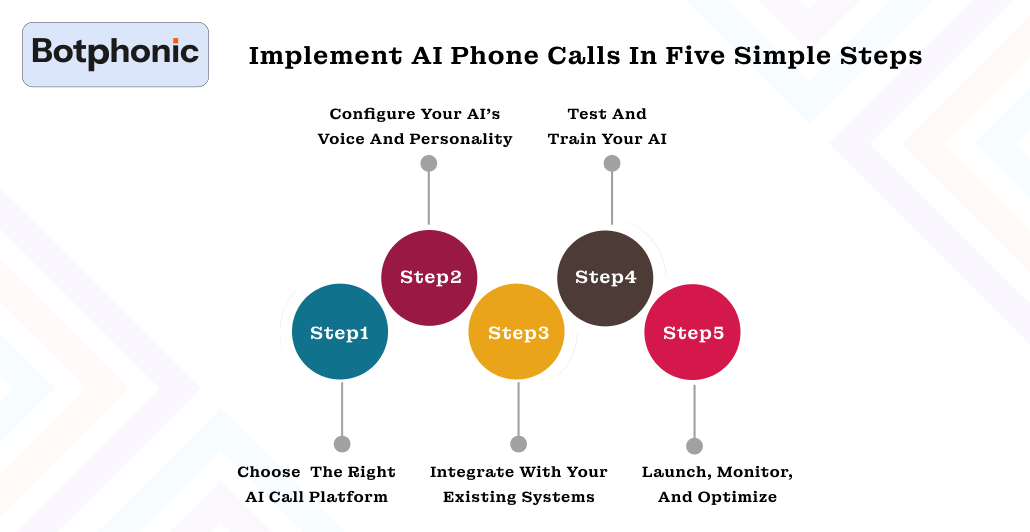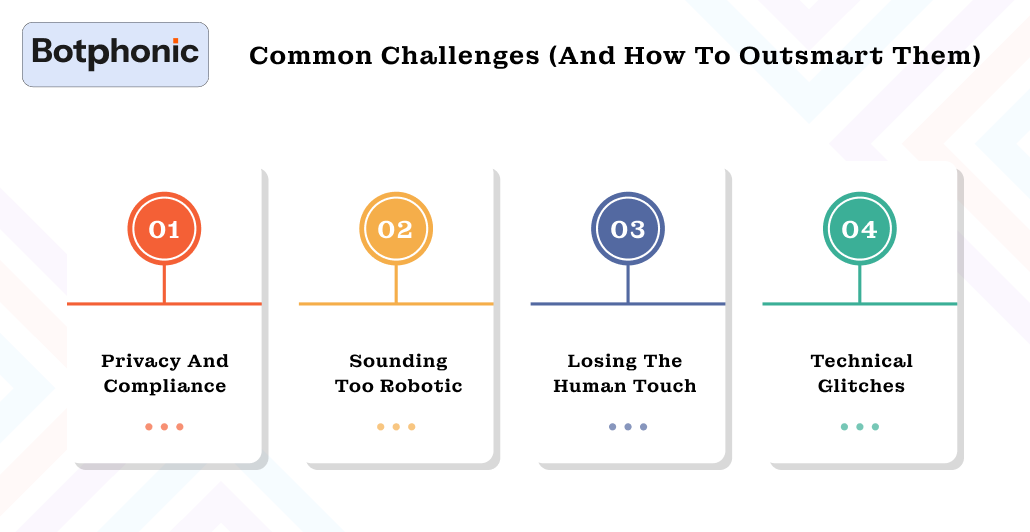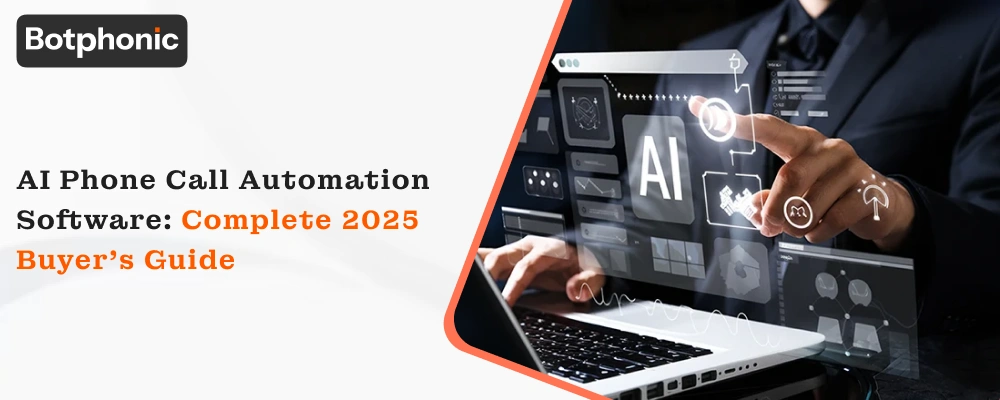
Summarize Content With:
Quick Summary
AI phone calls have shifted from long codes and lengthy procedures to just quick setups. As it has become an everyday business necessity, implementing these AI phone calls has also become one of the critical steps.
In this guide, you’ll learn how to set up AI phone calls in just five simple and actionable steps. You won’t require any unnecessary jargon or overcomplication.
Introduction
Have you ever wished to take off your most repetitive and time-sucking tasks? Well, you no longer have to be stuck on that; you can just choose smart business. AI phone call systems are revolutionizing communication and have allowed teams to automate outbound and inbound calls. While, It also helps in capturing notes, booking meetings, and even conversing naturally with customers.
Whether it’s an AI phone call agent who is scheduling appointments or an AI call assistant following up on leads, it might also be two AI agents on a phone call who are collaborating on task coordination. The technology has now matured beyond novelty and is getting optimized across sectors.
Exploring AI Phone Calls
An AI phone call uses machine learning and natural language processing to enable a digital assistant who can hold real conversations with humans over the phone, without any manual intervention. These AI systems are engineered in a way that can think, respond, and adapt on its own. While simulating a true human interaction.
You can think of it as modifying your phone with a brain; your AI phone call agent is now able to:
- Understand speech patterns and tone.
- Reply contextually to the user.
- Executing commands, such as sending follow-up emails or even updating a CRM.
Now you have made yourself a 24/7 available personal assistant.
Let’s know the tech behind this miraculous agent.
AI phone calls run on not just one but several foundational technologies, such as:
- Automatic Speech Recognition (ASR): Documents speech into text.
- Natural Language Processing (NLP): Detects meaning and context behind inquiry.
- Text-to-Speech(TTS): Shares realistic and human-like voices.
- AI Workflow Engines: Integrate the system with your CRM, Calendar, or ticketing tools.
When combined, these systems create an AI voice phone call that handles complex dialogues, from appointment booking to order verification. All this occurs without requiring human attention.
The Business Case for AI Phone Calls
The beauty of AI in telephony can usually be seen through its double advantage: scalability and personalization. Let’s see the reason why more and more organizations are marching into the future.
- Unmatched Efficiency: AI call assistants are made to handle many simultaneous conversations. You can just think of replacing your old hold music with a quick and instant response. There are no queues or frustrated customer waiting for you.
- Brand Consistency: Every AI interaction made follows your brand’s tone and sounds professional as well as polished. It ensures that to never slip, even if they are working under pressure or have been present 24/7.
- Real-Time Documentation: An AI phone call note takes works on recording notes and transcribing every conversation automatically. There won’t be any lost context or manual note-taking.
- 24/7 Availability: AI doesn’t need any sleep pr break. It’s always ready to pick up your call, whether you have a question in mind at 3 A.M or 3 P.M. It’s one of the most perfect creations for global operations.
- Cost Optimization: When replacing routing calls with an AI phone call agent, it reduces labor costs and improves accuracy as well as response time at the same time. It’s not about replacing real agents but allowing them to focus on potential clients.
Implement AI Phone Calls In Five Simple Steps

Now that we have explored the reasons why we should do it, let’s get practical and learn a simple five-step AI phone call setup guide.
Step 1. Choose the Right AI Call Platform
Whatever field you are looking to explore, a foundation is one of the most necessities. The platform you pick is what defines your systems’ flexibility and performance. When selecting your platform, consider a few of these conditions:
- Integration Compatibility: Is it offering the right connection with your CRM, Slack, or calendar?
- Voice Quality: Synthetic or hyper-realistic, select the voice based on your brand voice.
- Pricing Structure: Ensure to search for usage-based models that can scale when required.
- Compliance: Ensure your platforms are designed with GDPR, HIPAA, or SOC-2 readiness.
If you have chosen to take tests or demos of selected platforms, try using character AI phone calls to simulate how different brand personas sound and engage with clients.
Step 2: Configure Your AI’s Voice and Personality
This is the point where your AI assistant turns into a “somebody” rather than a “something”.
Contemporary AI telephone systems allow you to customize:
- Voice Style: Preference of being friendly, formal, or energetic.
- Accent and Gender: Either a regional fit or a brand’s persona match.
- Tone Adaptability: switching from professional to empathetic is possible.
Have you thought of being different? Character AI phone call settings can be used to create branded voices – a picture of “Siri meets your company culture”. If your AI has a human-like and striking personality, users will stay longer and trust it more.
Step 3: Integrate with Your Existing Systems
Your AI call assistant needs context, which is provided by data. The systems that are backing your business up should be the ones connected to your AI call assistant.
Integrations that should be given priority:
- CRM: No more manual work to log calls and update lead status in the system. All will be done automatically.
- Calendars: Get your AI to schedule or reschedule appointments.
- Email & SMS: After-call, send confirmations or follow-ups.
- Analytics Dashboards: Keep monitoring success metrics as they happen.
This configuration will transform the AI for the internal teams into a complete phone call agent capable of managing the outreach pipeline, customer service queue, and scheduling all from a single interface.
It is a good idea to have an AI phone call note taker integration activated when the setup is done. You will then receive searchable and structured call summarizations – a treasure for training and auditing purposes.
Step 4: Test and Train Your AI
No AI is perfect from the very start. It needs to be adapted up a bit.
Initially, let internal test calls do their job in determining:
- Misunderstanding: The words or accents that your AI finds hardest to hear.
- Tone Misalignment: Is the voice far too mechanical, or are the dialogs too frisky? Then, the speech model should be changed accordingly.
- Latency Problems: The time lag between the interpretation of the speech and the reply.
Using two AI agents in a phone call, you can easily simulate real dialogues — this is a smart way to put the conversational logic under stress. Let one AI play the role of the caller and the other the role of the receiver, then examine the conversation.
Training consists of:
- Putting the transcripts from real conversations into the models to make the language models more potent.
- Adjusting for exceptions (like slang, background noise…).
- Getting input from the customers and human agents.
Keep in mind that the difference between the “okay” AI and the “exceptional” AI is the continuous learning.
Step 5: Launch, Monitor, and Optimize
It is your creation. Now it is time to go live, but wisely. Pilot rollout for just one department or type of call is an optimal way to start.
Monitor KPIs like:
- Mean call duration
- First-call resolution rate
- Customer satisfaction scores
- Error or dropout rates
Then, analytics will be your aide in improving, if:
- Customers cut the call short; then your intro script is not good.
- Accuracy is low, then it is necessary to retrain on specific language terms.
- Sentiment goes down, then it is time to change the tone and pace of response.
Eventually, the AI will turn into a skilled call worker who will get better every time, learning from the interaction.
Schedule weekly optimization sprints during which you will review call logs and transcripts. Continuous tuning is the key to keeping the performance high and for the product to continue to be one of the top-rated ones in the customer service surveys.
Common Challenges (and How to Outsmart Them)

The finest mechanisms blow up sometimes. Here’s how to stay one step ahead.
1. Privacy and Compliance
AI usage involves highly confidential information. Make sure:
- Prior agreement is given clearly to conduct the recording.
- Storage is done securely through encryption and with limited access.
- Handling of personal information complies with GDPR regulations.
2. Sounding Too Robotic
This leads to disengagement. Remedy it by:
- Using intervals and “ums” to make it more realistic.
- Learning emotional tone ranges.
- Picking TTS models of very good quality that have human-like intonation.
3. Losing the Human Touch
AI should not replace sympathy but rather amplify it. Mix human hand-offs for tricky calls. The best approach is a model of an AI call assistant that combines personas to deal with edge cases.
4. Technical Glitches
Poor connection or high latency can easily aggravate users. Always perform redundancy checks and network testing across different time zones before the actual launch.
Start your AI call transformation today and set up an AI phone call agent.
Book Demo Now!!Benefits of Using AI for Phone Calls
An AI phone call has become an operational powerhouse. Let’s do a quick rundown of what you might gain when you are implementing AI into your calling strategy.
- Scalability on Demand: The AI system is engineered in a way that it can handle 5 to 5,000 calls. Moreover, it can scale faster than any agent ever could.
- Consistency with Character: There are no requirements for off days, there won’t be any bad-mood employees or inconsistent flow of answers to clients. Your brand voice will stay rock-solid across all the calls.
- Time Liberation: Teams can simply move beyond repetitive questions, such as “Are you available at 1, today?” and focus on closing deals that really help in driving results.
- Data-Driven Precision: Every call eventually becomes a data point. It proceeds with analysis, is transcribed, and converted into insight that will actually mean something for sales, service, and strategy.
- Round-the-Clock Reliability: AI never clocks out of the job. It ensures that it runs smoothly 24/7, so global operations aren’t skipping a beat.
AI phone call setup is one of the key advantages you can take and enhance your modern operations, with speed, accuracy, and scalability, without even sacrificing human connection. The system usually depends on how it listens, speaks, learns, and grows alongside your business.
Conclusion
AI phone call setup has become the “It” trend in 2025. The companies aren’t just automating calls, but they are transforming the way they connect with people. It has become more about building smarter workflows, sharper communication, and custom experiences. These elements make every interaction feel personal without requiring human intervention.
Blending machine learning, NLP, and speech tech has allowed these systems to hold conversations like a human and work alike. Even booking meetings to logging CRM notes has allowed agents to free up time and improve efficiency, while keeping communication consistent.

